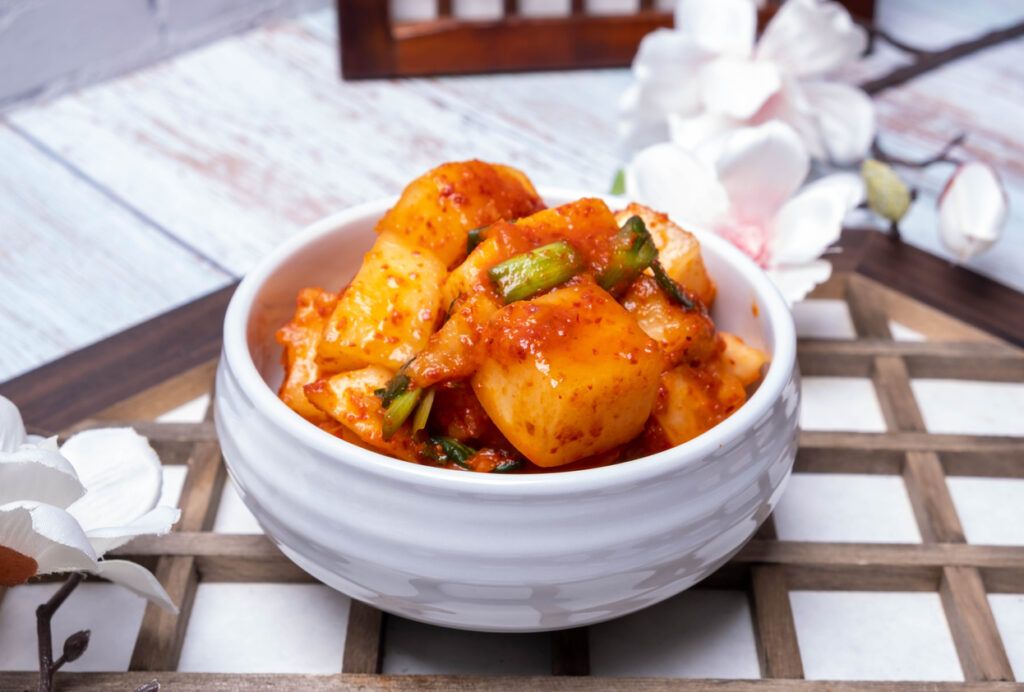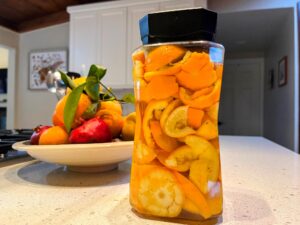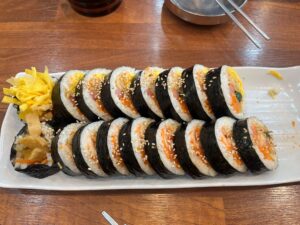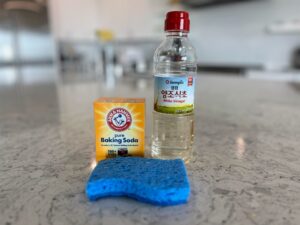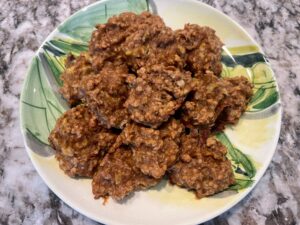Looking for a simple and flavorful Korean radish kimchi recipe? This crunchy, slightly sweet, and spicy kimchi—called kkakdugi in Korean—is one of my favorite side dishes. This radish kimchi is super easy to make, contains no refined sugar, and pairs perfectly with rice, stews, or any Korean meal.
Why I Love Kimchi
I have such fond memories of my mother making large batches of kimchi every fall. She’d gather napa cabbages and other seasonal vegetables to prepare enough to last through the long, cold Korean winter.
She always said, “Without kimchi, it feels like we have nothing to eat.” And she was right. For Koreans, kimchi isn’t just a side dish—it’s a daily essential and a key ingredient in so many recipes.
While napa cabbage kimchi is the most well-known, Korean radish kimchi has always been one of my personal favorites. It’s not only simpler to make but also incredibly refreshing. Unlike cabbage kimchi, which is often added to stews or stir-fries, radish kimchi is typically served on its own as a banchan—a flavorful side dish that stands out on its own.
With its natural crunch and spicy kick, it’s perfect with a bowl of warm rice or even tossed on top of a salad for a bold, Korean-inspired twist.
Health Benefits of Korean Kimchi
Korean radish kimchi isn’t just tasty—it’s also full of health benefits too. This tangy, crunchy side dish does more than just add flavor to your meals. Here’s why it’s a smart (and healthy) choice:
1. Rich in Probiotics
Like other fermented foods, Korean radish kimchi is loaded with good bacteria that support gut health. What’s more, these probiotics help with digestion and give your immune system a natural boost.
2. Boosts Immunity
In addition, ingredients like garlic, ginger, and chili peppers give radish kimchi powerful immune-supporting properties. These ingredients can help fight off common colds and keep your body strong.
3. Aids Digestion
Additionally, the fermentation process makes the radish easier to digest and can reduce bloating. That’s why it’s a great way to support your digestive system naturally.
4. Supports Heart Health
This kimchi is also packed with fiber and antioxidants, which can help lower cholesterol and improve circulation.
5. Full of Nutrients
Korean radish kimchi is also rich in vitamin C, vitamin K, and potassium. Therefore, these nutrients support everything from strong bones to a healthy immune system.
6. Low in Calories
This radish kimchi is light, low in calories, and made without refined sugar—just the natural sweetness from the radish. That’s why it’s a smart choice if you’re watching your weight or cutting back on sugar.
Korean Radish Kimchi Recipe
Here’s a simple recipe to make Korean Radish Kimchi with easy ingredients without added sugar:

Ingredients
- 2 lb Korean daikon radish
- 3–5 cloves garlic, minced
- 1 tsp minced ginger
- 1 tbsp Kosher or coarse salt (adjust to taste)
- 1/4 cup sweet yellow onion
- 1/3 cup carrot
- 1/2 small, sweet apple (Fuji is best)
- 2–3 tbsp Korean red pepper flakes (adjust to spice preference)
- 1 green onion (optional)
- 1/2–1 tbsp fish sauce (optional, for non-vegans)
Instructions
1. Wash and Dry:
To begin making your Korean radish kimchi, wash the radish, carrot, apple, onion, and green onion (if using). Pat them dry to avoid excess moisture during fermentation.
2. Cut the Radish:
Then, cut the Korean daikon radish into 1×1-inch cubes and place them in a large mixing bowl.
3. Blend the Base:
Next, blend the garlic, ginger, onion, carrot, and apple until the mixture is slightly chunky. Then, pour it over the radish and set it aside for the next step.
4. Add Green Onions:
After that, slice the green onions into 1–2 inch pieces and mix them in.
5. Mix Everything:
Now, add the salt, red pepper flakes, and fish sauce (if using). Put on gloves and mix everything well. It may look dry at first, but the radish will release liquid over time.
6. Pack and Seal:
Once fully mixed, transfer the mixture into a clean jar. Then, press it down firmly to release juices and remove air pockets. As it ferments, the volume will reduce by about one-quarter.
7. Let It Ferment:
Leave the jar at room temperature for 2–3 days. You’ll notice bubbles forming as it ferments.
8. Refrigerate and Enjoy:
Finally, move your Korean radish kimchi to the fridge. It will continue to ferment slowly and can be enjoyed for 2–3 weeks.
Tips from My Mother
When making Korean radish kimchi, don’t be shy with the garlic. My mother, who’s been making kimchi all her life, always says, “The more garlic, the better.” It not only adds bold flavor but also helps preserve the kimchi, keeping it fresh longer.
Another important tip: skip the regular table salt. Instead, use coarse salt like Kosher or coarse sea salt. This type of salt draws out moisture properly and helps give your radish kimchi that perfect crunch and clean, fresh taste.
As for the fermentation process, timing can vary. Warmer temperatures will speed up fermentation, while cooler temperatures slow it down.
It also comes down to personal preference. My daughters love their kimchi well-fermented, while I prefer it a bit fresher—it lasts longer in the fridge and has a lighter taste.
Make Delicious Radish Kimchi at Home
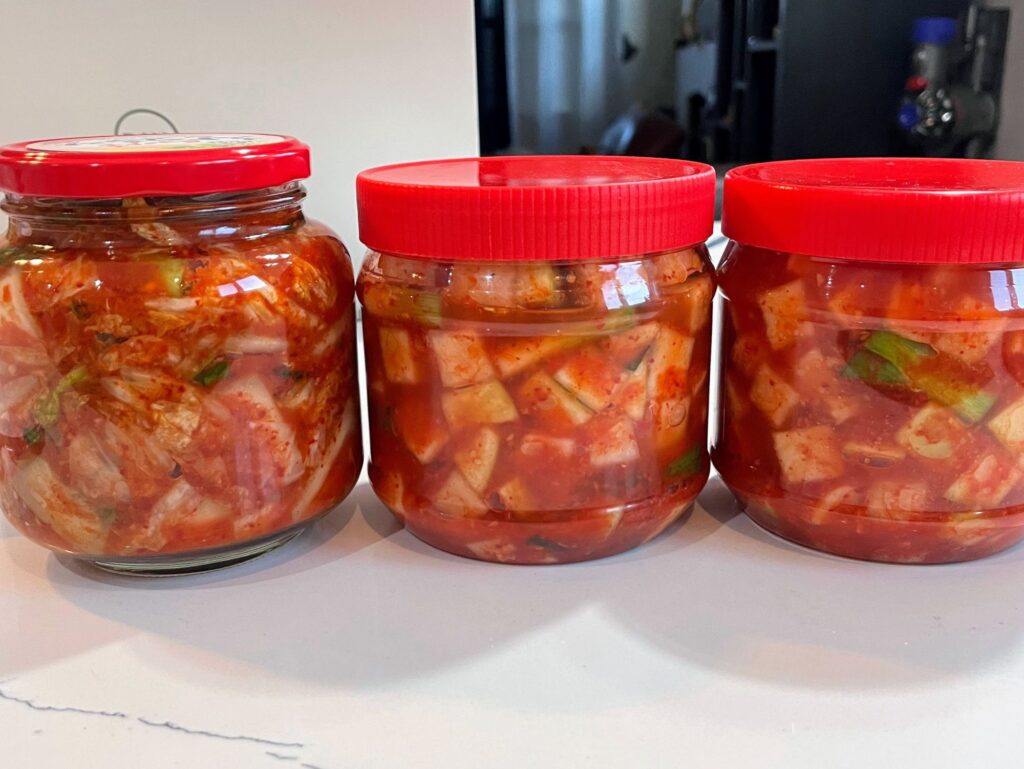
Korean radish kimchi is one of those dishes that’s both fun to make and deeply satisfying to eat. It’s fresh, crunchy, and full of bold flavor—striking just the right balance of spice and natural sweetness. Best of all, this radish kimchi is made without refined sugar, making it a healthier choice for those watching what they eat.
Once you get the hang of it, making it at home becomes quick and rewarding. In fact, you might never want to buy store-bought again. It’s a simple, delicious way to enjoy a taste of Korean tradition—right from your own kitchen.

